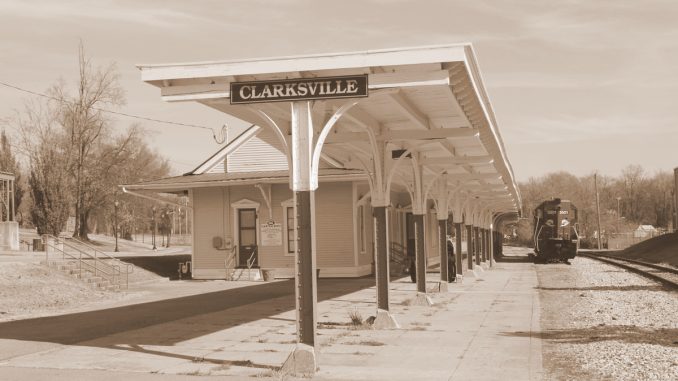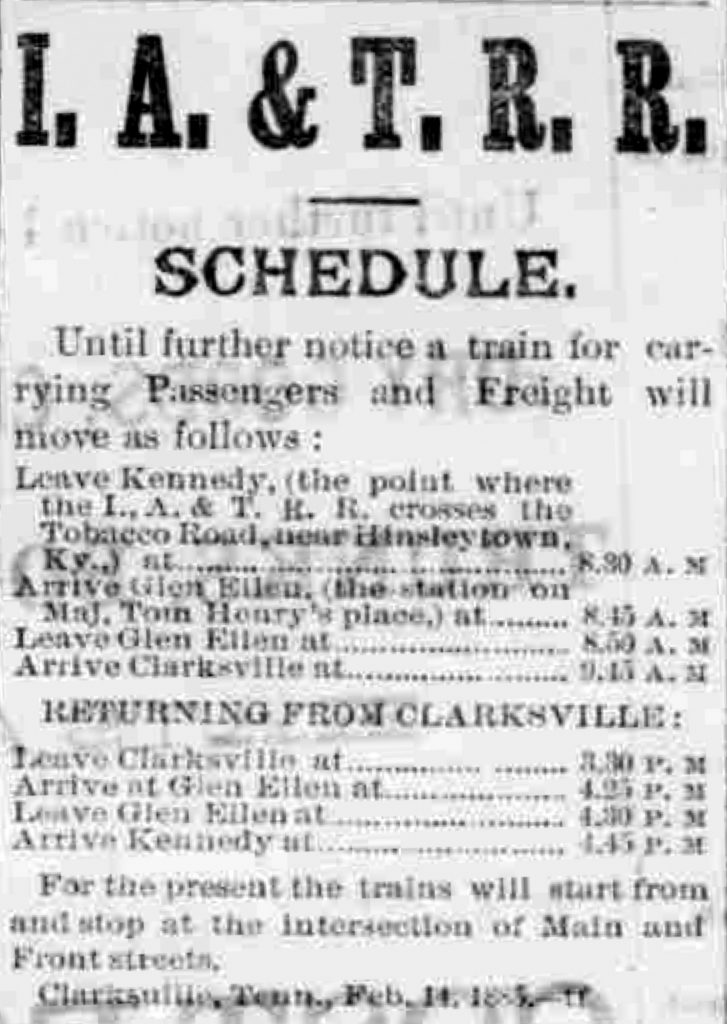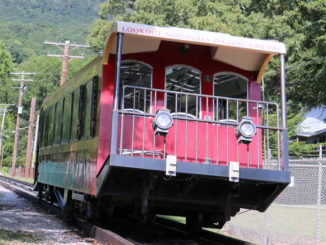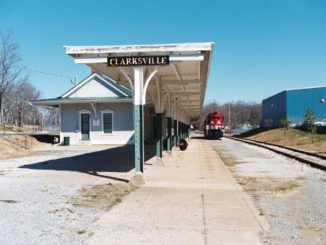
A railroad proposed to run from Mobile, Alabama, to Evansville, Indiana, via Clarksville, Tennessee, emerged in the early 1880s.
The Indiana, Alabama & Texas Railroad has a confusing corporate history. Despite its name, the railroad only built 58 miles of track in Tennessee and Kentucky.
Even though some paperwork was filed earlier, the Indiana, Alabama & Texas Railroad Company formally emerged in July 1885 after merging together three lines:
- The Mobile, Clarksville & Evansville incorporated in late 1881 in Tennessee to build from the Tennessee-Kentucky line to the Tennessee-Alabama line north of Florence, Alabama.
- The Princeton & Ohio River Railroad incorporated in February 1882 to build from to Princeton, Kentucky, to a point on the Ohio River near the mouth of the Green River.
- The Indiana, Alabama & Texas formed in either October 1881 or February 1882 in Alabama. The company subsequently elected E.C. Gordon as president, W.B. Wood as vice president and Walter S. Gordon as secretary and treasurer.
In Tennessee, Mobile, Clarksville & Evansville organizers sought funding from Montgomery County the city of Clarksville to construct its line. A meeting on February 1, 1882, aimed to iron out the details of the proposed road, and on February 18, 1882, The Clarksville Weekly Chronicle published the meeting’s minutes:
Whereas, It is proposed by the Gordon railroad company to construct a railroad from Mobile, Ala., to Evansville, Ind., to pass through Clarksville, Tenn., and through the counties of Christian, Trigg, Caldwell, Hopkins, Webster, Union and Henderson in the State of Kentucky; and
Whereas, Said company proposes to build said railroad upon condition that the people contribute in aid of said railroad, a subsidiary of $5,000 per mile, or build one mile in five; and
Whereas, We have the assurance that said company have the ability and will certainly and promptly comply with their proposition immediately and build said road with the utmost dispatch as soon as the subsidiary asked is raised.
Some of the people who were instrumental in building the earlier Memphis, Clarksville & Louisville returned to their railroad roots and helped bring a new road to life.
Two decades earlier, D.N. Kennedy declined the role of Memphis, Clarksville & Louisville president. However, this time around, he accepted a similar role with the new Mobile, Clarksville & Evansville.
The group also elected H.C. Merritt as its Secretary and Treasurer. At the same time, Judge C.G. Smith of Clarksville successfully motioned to set the capital stock was set at $2,500,000. Individual shares were fixed at $100.
The February 25, 1882, edition of The Clarksville Weekly Chronicle indicated railroad officials “are now vigorously at work all along the line getting up their subscriptions.” The same article predicted the road would be up and running by March 1, 1883, and lauded the railroad. “The people who possess such a spirit of enterprise will always succeed,” the paper wrote, offering a similar excitement as the papers did three decades earlier as workers built the Memphis, Clarksville & Louisville.
Nothing will save this country from utter ruins but railroads, manufactories and a new system of farming. We must get out of old ruts. It is a shame and disgrace to our people that there is so little enterprise and so much selfishness among them. This selfishness is eating out the very life and soul of the country and the people. We must get out of it.
In three weeks, The Clarksville Weekly Chronicle reported, the city of Clarksville raised $60,000 for its subscription to the railroad. Other cities, according to the paper, such as Princeton, Kentucky, would also complete her subscription fee of $30,000. But not all was certain in terms of funding for the road. As a result, the company constructed a poorly built three-foot gauge line.

A timetable, which ran in the March 14, 1885, edition of The Clarksville Weekly Chronicle, indicates a schedule change. Trains would leave Kennedy, Kentucky, a small community in southwest Christian County, Kentucky, at 8:30 a.m. and arrive at Clarksville at 9:45 a.m. At 3:30 p.m., a train would depart Clarksville and arrive in Kennedy, Kentucky, at 4:45 p.m. “For the present the trains will start from and stop at the intersection of Main and Front streets.”
The Louisville & Nashville purchased the Indiana, Alabama & Texas in 1886 and took possession or the road by the end of 1887, making it a sister line of the former Memphis, Clarksville & Louisville. In an 1887 report, the Louisville & Nashville noted the railroad “had virtually no terminal facilities at Clarksville.”
After acquiring the road, the Louisville & Nashville built new facilites and converted the line its standard gauge of four feet, nine inches. The road was later known as the Clarksville & Princeton Branch. The Louisville & Nashville abandoned the route following the May 13, 1933, run of a mixed train.





